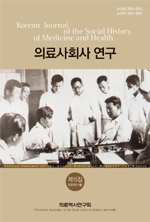근대여성의학교육과 도시 공간: 조선여자의학강습소와 경성여자의학강습소를 중심으로
Modern Women’s Medical Education and Urban Space: The Case of the Korean Women Medical Institute and the Woman’s Medical Institute at Seoul
- 의료역사연구회
- 의료사회사연구 [ISSN : 2635-6333]
- 제15집
-
2025.0443 - 76 (34 pages)
-
DOI : 10.32365/KASHM.2025.15.2
- 184

한국 여성의학교육은 1928년 조선여자의학강습소가 설립되면서 본격적으로 시작되었다. 이 강습소는 창신동 131번지에 있던 루이스 부인의 주택을 개조하여사용하였으며, 이후 관철동 141번지로 이전하면서 경성여자의학강습소로 개칭되었다. 두 시설 모두 독자적인의료교육기관이 아닌 기존 건물을 전용하여 사용한 것이 특징이다. 부속의원이 없었던 조선여자의학강습소와 달리 경성여자의학강습소는 부속의원을 갖추고 있었으나 규모가 작아 경성여자의학강습소 시절에도 학생들은 주로 외부 병원에서 실습교육을 받아야 했다. 즉, 1928년조선여자의학강습소 설립부터 1938년 경성여자의학전문학교 설립까지의 10년간은 여성의학교육이 본격적으로 시작된 시기이지만, 공간적으로는 아직 완전한 체계를 갖추지 못한 과도기적 단계였다. 본 연구는 조선여자의학강습소 및 경성여자의학강습소의 위치와 공간적 특징을 구체적으로 밝히고, 이들이 식민지 경성이라는 도시 내에서 어떻게 활용되고 확장되었는지를 조망하는 데 목적을 두었다. 이를 위해 두 강습소의 위치를 최대한 정확하게 고증하고, 당시 유사한 건물들과 비교하여 건축적·공간적 특징을 분석하였다. 또한, 도시공간의 맥락 속에서 조선여자의학강습소가 서양인 의료선교사 중심의 여성의료선교 활동이 이루어지던 창신동에 위치한 반면, 조선인 의사들이 주도한 경성여자의학강습소는 청계천 주변, 즉 갓 경성으로 이주한 가난한 이들이 정착한 지역에 자리했음을 밝혀냈다. 이를 통해 각 강습소를 이끈 인물들의 성격과 교육 방향이 장소적 특징과 연계됨을 확인할 수 있었다. 아울러, 소규모 시설에서 이루어진 의학교육의 특성상 학생들은 경성 전역의 병원에서 실습을 받았음을 밝혀냈다.
The formal education of women in medicine in Korea began with the establishment of the Korean Women Medical Institute (KWMI) in 1928. Initially housed in the repurposed residence of Mrs. Lewis at 131 Changsin-dong, the institute later moved to 141 Gwanchul-dong and was renamed the Woman’s Medical Institute at Seoul (WMIS). Both institutions operated in existing residential buildings rather than purpose-built medical education facilities. Unlike the KWMI, which lacked an affiliated clinic, the WMIS operated one; however, due to its limited scale, students still had to complete clinical training at external hospitals. The ten-year period from the founding of the KWMI in 1928 to the establishment of the Keijo Women’s Medical College (KWMC) in 1938 marked the formal beginning of women’s medical education in Korea, though it remained a transitional phase lacking fully developed architectural infrastructure. This study aims to identify the precise locations and spatial characteristics of the KWMI and the WMIS, shedding light on how spaces for women’s medical education were utilized and expanded within colonial Seoul. To this end, the locations of the two institutes were verified as accurately as possible, and their architectural and spatial features were analyzed in comparison with contemporary buildings. In addition, within the urban context, it was found that the KWMI was located in Changsin-dong—a center of women’s medical missionary work led by Western missionaries—while the WMIS, led by Korean doctors, was situated near Cheonggyecheon, an area inhabited by newly arrived and impoverished residents. This spatial analysis reveals that the educational philosophies and activities of each institution were closely related to their respective locations. Furthermore, the limited scale of these facilities meant that students received clinical training at various hospitals across Seoul.
1. 머리말
2. 창신동 조선여자 의학강습소의 위치와 공간
3. 관철동 경성여자 의학강습소의 위치와 공간
4. 도시적 맥락에서 살펴본 여자의학강습소의 장소적 특징
5. 맺음말
(0)
(0)